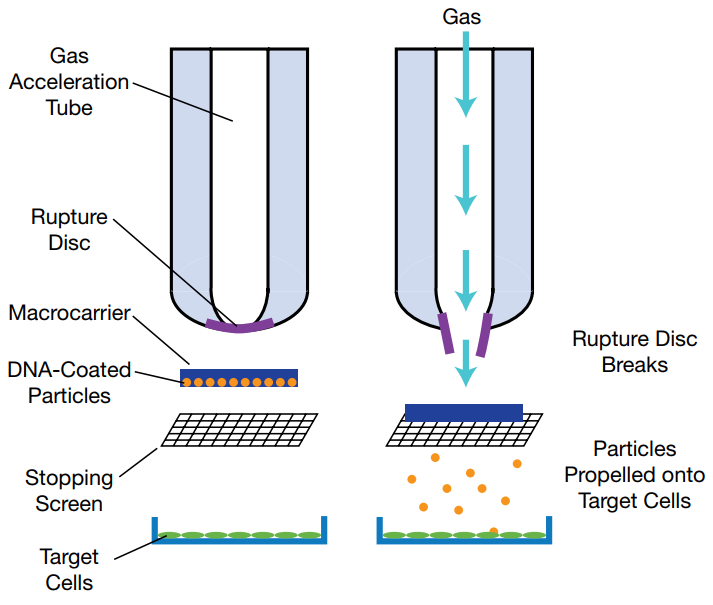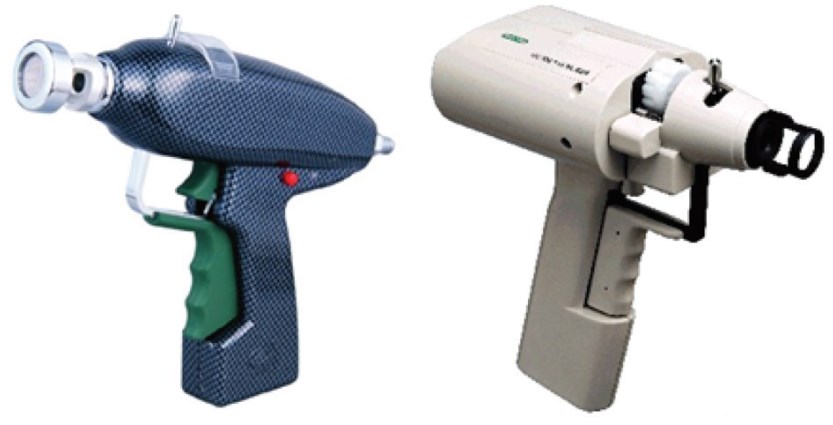Bombardment with DNA-Coated Microparticles (“Gene Gun”)
Introduction of Gene Gun
The particle bombardment, also known as the gene gun, is a direct physical method of gene delivery (introducing nucleic acids into cells). It is a device used to transfect cells with foreign DNA by bombarding the target cells with DNA-coated microparticles. In this method, nucleic acids or other biological molecules are coated onto high-density gold or tungsten microparticles (microcarriers), then they are accelerated to high velocity by a helium pulse and driven through cell walls and membranes into the target (Fig.1). The gene gun was originally developed to deliver genetic materials into plant cells. Today, this technique has been used to transfer DNA coated micro-particles to achieve gene transfection into many types of cells and organs, including cell cultures, tissues, organs, plants, animals, fungi and bacteria, as well as organelles.
 Figure 1. Gene gun or particle bombardment delivery device can deliver transgenes to cells. (Demirer, 2017)
Figure 1. Gene gun or particle bombardment delivery device can deliver transgenes to cells. (Demirer, 2017)
How the Gene Gun Works?
Many commercial gene guns have been manufactured and used for in vivo gene transfection in plants, living animals, cultured cells, such as the PowderJect system developed originally by the University of Oxford, the Helios gene gun by Bio-Rad, Hercules, CA, and the SJ-500 portable gene gun by Biotech instrument, New Jersey. The Helios and portable gene guns are shown in Fig.2. Nucleic acid transfer using the gene gun is fast and effective: simply load sample cartridges with DNA coated microcarriers, point the nozzle, and launch the device. Gene guns generally include the following steps: 1) prepare the tungsten particles and coat them with DNA; 2) load the particles onto macrocarriers; 3) prepare the target cells; 4) determine your parameters and set the gene gun accordingly for distance from the target, pulse duration, and CO2 pressure; 5) place the target under the gene gun barrel and fire it.
 Figure 2. The commercial SJ-500 portable gene gun (left) and Helios gene gun (right). (Zhang, 2014)
Figure 2. The commercial SJ-500 portable gene gun (left) and Helios gene gun (right). (Zhang, 2014)
Why Choose Gene Gun?
Of all the transformation methods available, particle bombardment can be applied to a wide range of cell and tissue types. The size of the microcarrier and the helium pressure can be selected to optimally penetrate different targets while minimizing damage. When using this method, mammalian cells do not need to be trypsinized to remove them from their supports, so cell morphology can be maintained. Particle bombardment:
- Is the most effective way to introduce nucleic acids into plants because helium pressure can drive microcarriers through the cell wall;
- Is much easier and less time consuming than microinjecting nucleic acids into plant cells or embryos;
- Allows the transformation of animal cells that have unique growth requirements that are not suitable for gene transfer using any other method;
- Requires less DNA and fewer cells than other methods, and can be used for transient or stable expression.
Advantages of Gene Gun:
- This method is easy to use, fast and versatile;
- Effective transformation requires only a small amount of nucleic acid and few cells;
- High levels of co-transformation and codelivery of multiple plasmids are possible;
- Can transfer large DNA fragments as well as small interfering RNA (siRNA) for gene silencing;
- Can transfect many cell types, including non-dividing cells and plant cells;
- Avoid potentially toxic treatments (such as from viruses or chemical and lipid-based systems).
Application of Gene Gun
- Plant Systems
Particle bombardment is especially useful for cells and tissues that are refractory to other transformation methods, such as the agriculturally important monocotyledonous plants.
- Animal Systems
Particle bombardment has been used successfully for the transformation of intact animal tissues, animal cells, and embryos. It is one of the convenient and most effective methods for transforming these sensitive cells, as there is little need for pre- or post-bombardment operations.
- Other Biological Systems
Biolistic technology has been applied to various targets, such as chloroplasts, mitochondria, bacteria, fungi, algae, and pollen. Today, the gene gun is used for genetic transformation of many organisms to introduce a diverse range of desirable traits. For example, particle bombardment plays an important role in the transformation of organelles such as chloroplasts, which enables engineering of organelle-encoded herbicide or pesticide resistance in crop plants and to study photosynthetic processes. In addition, gene guns have been further used to study cancer, infectious diseases and wound healing, to generate immune responses in animals and measure gene expression and regulation in vivo and in vitro in recent years.
References
- Demirer, G. S.; Landry, M. P. (2017). Delivering genes to plants. Chemical Engineering Progress. 113(4).
- Zhang, D.; et al. (2014). Potential of microneedle-assisted micro-particle delivery by gene guns: a review. Drug Delivery. 21(8):571-87.
